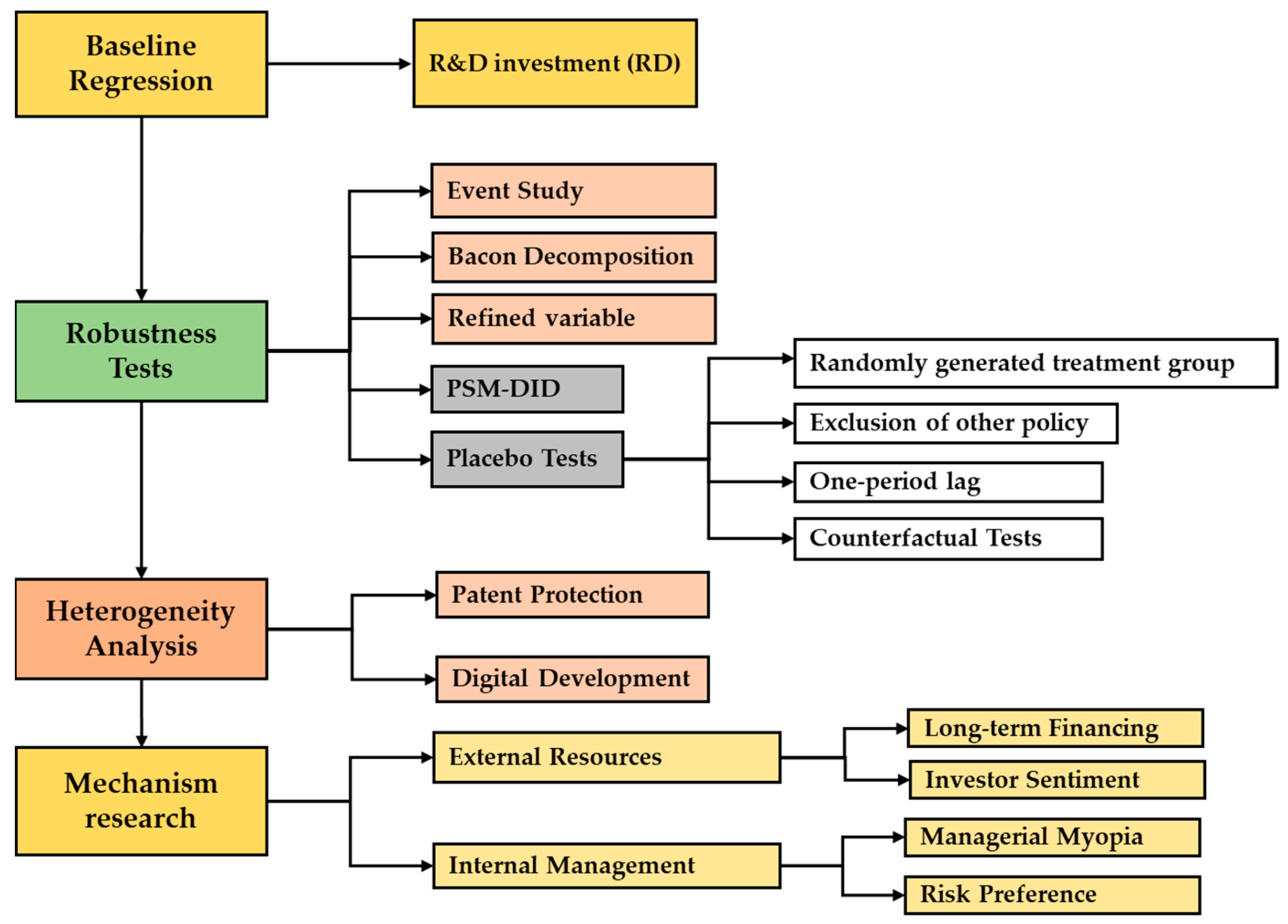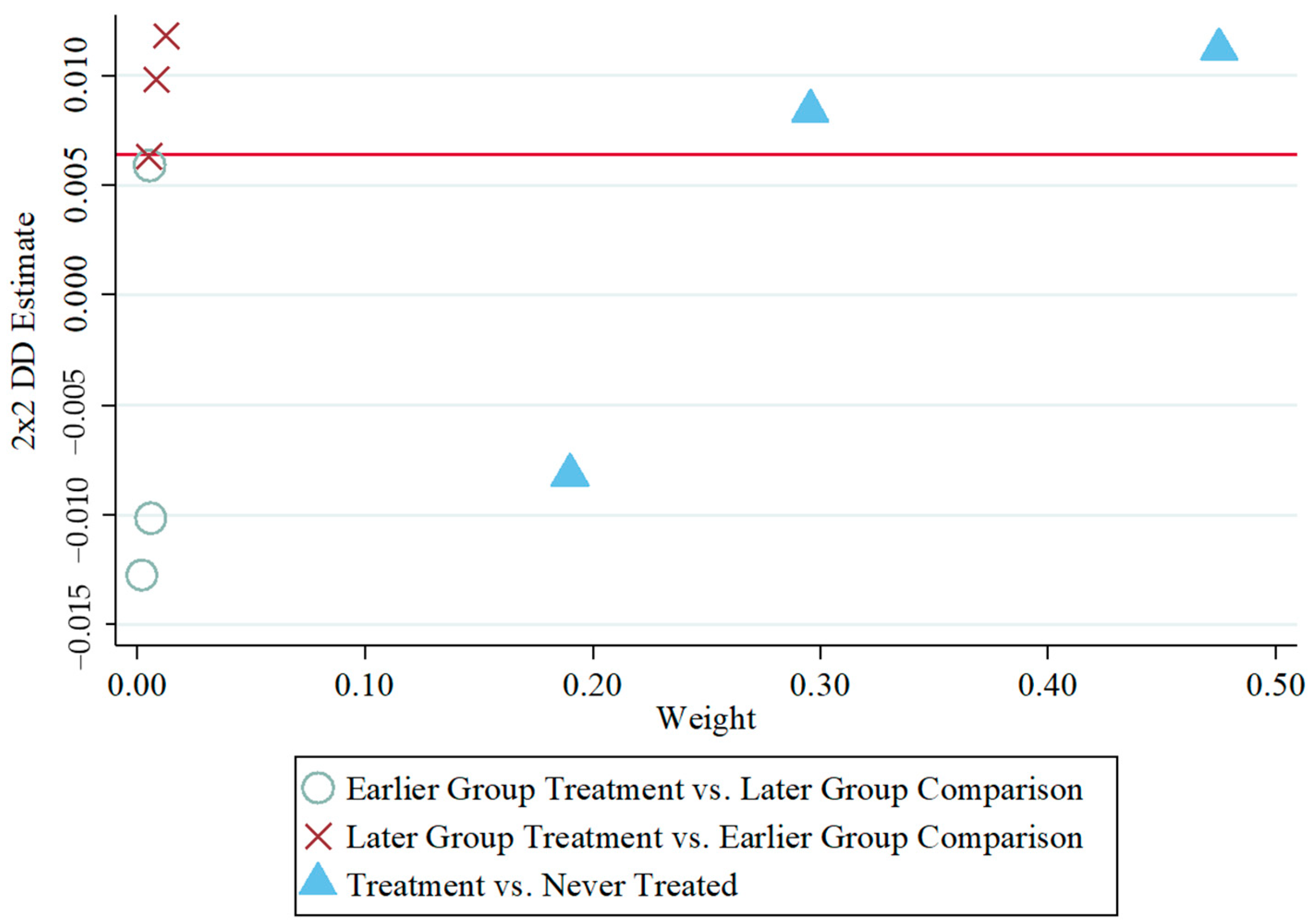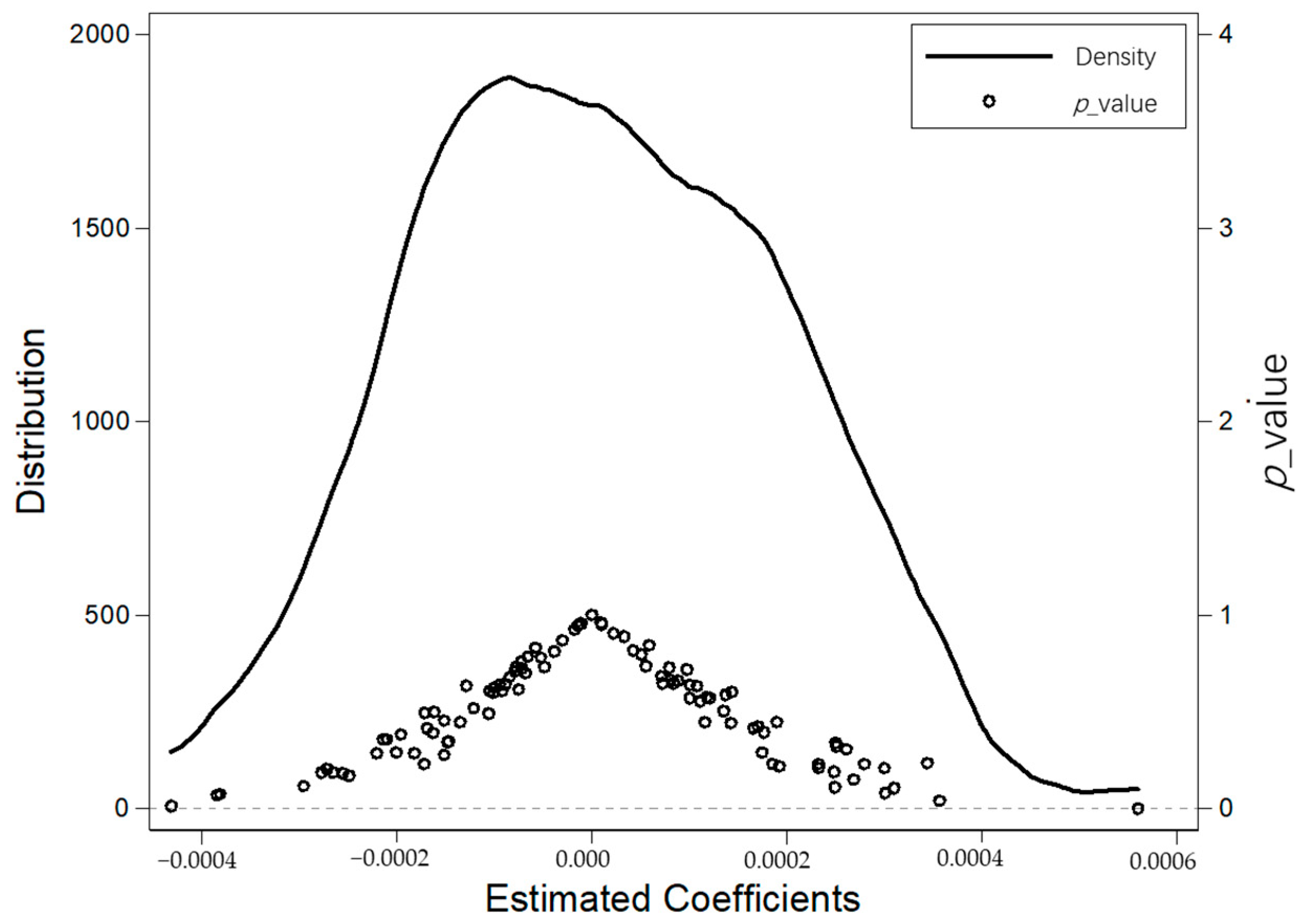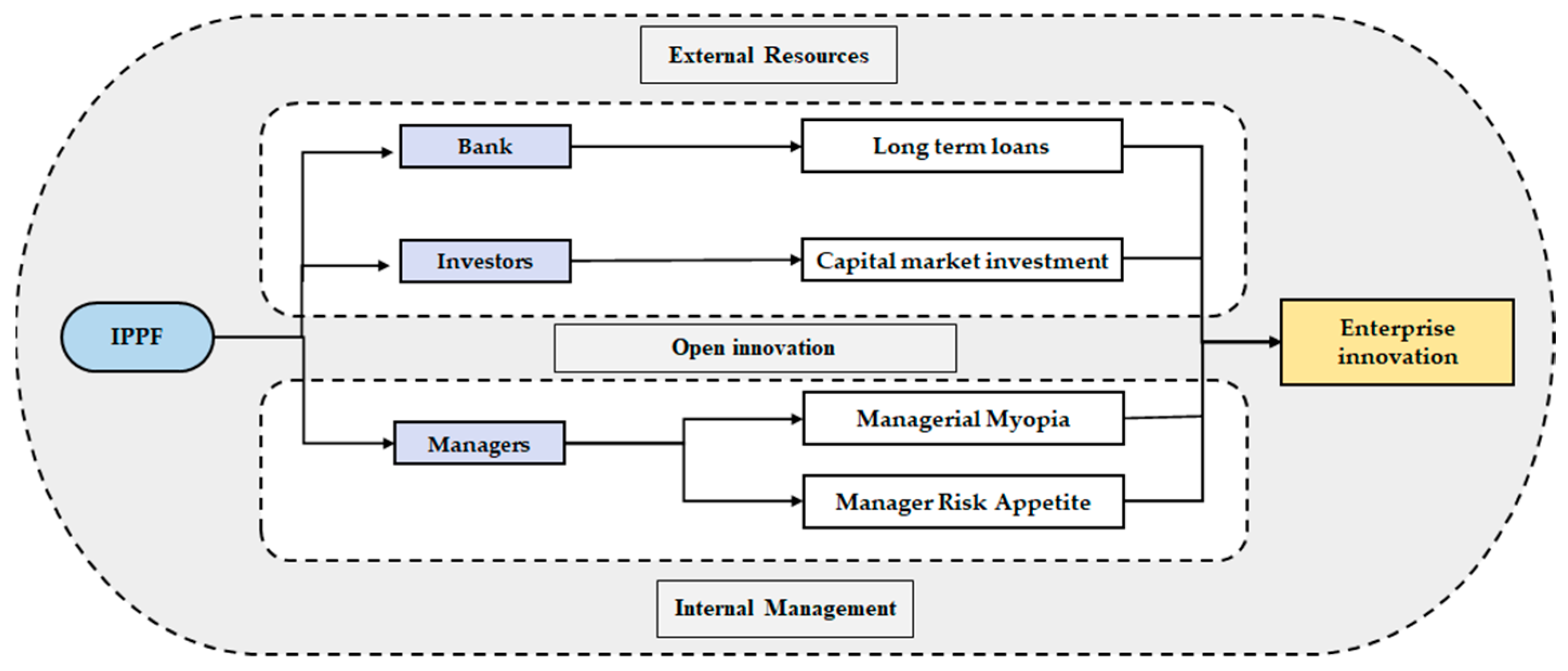Intellectual Property Pledge Financing and Enterprise Innovation: Based on the Perspective of Signal Incentive
Abstract
:1. Introduction
2. Literature Review
2.1. Factors That Influencing Enterprise Innovation
2.2. The Effects of IPPF on Enterprises
2.2.1. The Impact of IPPF on External Financial Resources
2.2.2. The Impact of IPPF on Internal Management
3. Data, Variables, and Methodology
3.1. Data Source
3.2. Variables Description
3.2.1. Enterprise Innovation
3.2.2. Intellectual Property Pledge Financing
3.2.3. Control Variables
3.2.4. Mechanism Variables
| Variable Type | Variable Name | Symbol | Measurement |
|---|---|---|---|
| Dependent variable | Enterprise Innovation | RD | R&D investment/Asset. See Section 3.2.1 |
| Independent variable | Intellectual Property Pledge Financing | IPPF | Dummy variable. See Section 3.2.2 |
| Control variables | Economy | GDP | Gross regional product |
| Profit | ROA | Net profit/total assets | |
| Equity Control | TOP1 | the shareholding proportion of the controlling shareholder | |
| Enterprise Maturity | Lnage | Years of establishment | |
| Independence of Directors | IND | Independent directors/directors | |
| Enterprise Size | Size | Total employees | |
| Mechanism variables | Managerial Myopia | Myopia | See Section 3.2.4 |
| Management Risk Prefer | Risk | See Section 3.2.4 | |
| Bank Financing | Long | Long-Term Loans | |
| Longratio | Long-Term Loans/Loans | ||
| Investor sentiment | IS | See Section 3.2.4 |
3.3. Descriptive Statistics
| Variable Type | Variables | Observations | Mean | Standard Deviation | Min. | Median | Max. | Skewness | Kurtosis |
|---|---|---|---|---|---|---|---|---|---|
| Dependent variable | RD | 16,396 | 0.020 | 0.018 | 0 | 0.017 | 0.094 | 1.648 | 6.686 |
| Independent variable | IPPF | 16,396 | 0.223 | 0.416 | 0 | 0 | 1 | 1.334 | 2.779 |
| Control variables | ROA | 16,396 | 0.038 | 0.059 | 0 | 0.0360 | 0.208 | −1.066 | 8.348 |
| IND | 16,396 | 0.199 | 0.038 | 0 | 0.200 | 0.500 | 0.553 | 4.603 | |
| TOP1 | 16,396 | 0.352 | 0.153 | 0.003 | 0.332 | 0.900 | 0.506 | 2.769 | |
| Lnage | 16,396 | 2.026 | 0.905 | 0 | 2.303 | 3.332 | −0.849 | 2.732 | |
| Size | 16,396 | 7.573 | 1.430 | 1.386 | 7.552 | 13.220 | −0.0440 | 4.349 | |
| GDP | 16,396 | 0.549 | 0.396 | 0.026 | 0.456 | 1.457 | 0.579 | 2.170 | |
| Mechanism variables | Myopia | 25,337 | 0.103 | 0.094 | 0 | 0.082 | 1.553 | 2.051 | 12.37 |
| Risk | 25,964 | 0.0340 | 0.0800 | 0 | 0.00300 | 0.981 | 15.38 | 350.6 | |
| Long | 21,101 | 0.152 | 0.857 | 0 | 0.005 | 32.950 | 2.081 | 7.252 | |
| Longratio | 21,101 | 0.056 | 0.087 | 0 | 0.015 | 0.417 | 4.444 | 29.26 | |
| IS | 22,590 | 0 | 1.023 | −5.310 | −0.164 | 6.630 | 1.919 | 9.869 |
| Background Information | Characteristics | Frequency | Percentage |
|---|---|---|---|
| IP Protection | High | 15,933 | 61.09 |
| Low | 10,150 | 38.91 | |
| Digital Development | High | 15,094 | 57.87 |
| Low | 10,989 | 42.13 |
3.4. Econometric Model
4. Results and Discussions
4.1. Baseline Regression
4.2. Robustness Tests
4.2.1. Event Study
4.2.2. Bacon Decomposition
4.2.3. Propensity Score Matching
4.2.4. Replacing Variables
4.2.5. Placebo Tests
| Variables | (1) | (2) | (3) | (4) | (5) |
|---|---|---|---|---|---|
| Pat | RD | RD | RD | RD | |
| IPPF | 15.805 ** | 0.002 ** | 0.002 ** | ||
| (2.29) | (2.18) | (2.26) | |||
| LCC | 0.001 ** | ||||
| (2.36) | |||||
| NIPDC | 0.0002 | ||||
| (0.51) | |||||
| LPolicy | 0.001 ** | ||||
| (2.21) | |||||
| DPolicy | 0.001 | ||||
| (1.00) | |||||
| Control | Yes | Yes | Yes | Yes | Yes |
| Year fixed effect | Yes | Yes | Yes | Yes | Yes |
| Enterprise fixed effect | Yes | Yes | Yes | Yes | Yes |
| Industry fixed effect | Yes | Yes | Yes | Yes | Yes |
| Constant | 31.770 *** | 0.020 *** | 0.020 *** | 0.023 *** | 0.018 *** |
| (3.58) | (9.73) | (9.86) | (5.91) | (7.67) | |
| Observations | 17,283 | 15,016 | 15,016 | 12,309 | 15,016 |
| Within R-squared | 0.302 | 0.762 | 0.762 | 0.787 | 0.762 |
| F Statistics | 2.136 | 3.142 | 2.816 | 14.954 | 1.507 |
4.3. Heterogeneity Analysis
| Variables | RD | |||
|---|---|---|---|---|
| (1) | (2) | (3) | (4) | |
| High IPP | Low IPP | Low DD | High DD | |
| IPPF | 0.026 *** | −0.002 | 0.0003 | 0.0028 ** |
| (3.62) | (−0.11) | (0.21) | (2.15) | |
| Control | Yes | Yes | Yes | Yes |
| Year fixed effect | Yes | Yes | Yes | Yes |
| Enterprise fixed effect | Yes | Yes | Yes | Yes |
| Industry fixed effect | Yes | Yes | Yes | Yes |
| Province fixed effect | Yes | Yes | Yes | Yes |
| Constant | 0.270 *** | 0.076 * | 0.0229 *** | 0.0176 *** |
| (5.73) | (1.85) | (44.05) | (88.69) | |
| Observations | 8271 | 5111 | 6676 | 7834 |
| Within R-squared | 0.798 | 0.749 | 0.7811 | 0.7812 |
| F Statistics | 7.837 | 5.192 | 0.0422 | 4.6392 |
4.4. Influencing Mechanisms
4.4.1. External Resources
4.4.2. Internal Management
| Variables | (1) | (2) | (3) | (4) | (5) |
|---|---|---|---|---|---|
| Long | Longratio | IS | Myopia | Risk | |
| IPPF | 0.119 *** | 0.007 ** | 0.083 ** | −0.014 *** | 0.007 ** |
| (2.81) | (2.18) | (2.07) | (−3.35) | (2.22) | |
| Control | Yes | Yes | Yes | Yes | Yes |
| Year fixed effect | Yes | Yes | Yes | Yes | Yes |
| Enterprise fixed effect | Yes | Yes | Yes | Yes | Yes |
| Province fixed effect | Yes | Yes | Yes | Yes | Yes |
| Industry fixed effect | Yes | Yes | Yes | Yes | Yes |
| Constant | 0.021 | −0.514 *** | −0.905 *** | 0.105 *** | 0.038 *** |
| (1.22) | (−12.13) | (−21.70) | (38.16) | (10.13) | |
| Observations | 21,101 | 21,100 | 22,590 | 25,337 | 22,562 |
| Within R-squared | 0.026 | 0.064 | 0.063 | 0.024 | 0.068 |
| F Statistics | 10.021 | 21.503 | 60.601 | 53.921 | 44.776 |
5. Discussion and Conclusions
5.1. Research Conclusions
- (1)
- Despite the limitations of China’s current intellectual property protection framework and the relatively short implementation period of IPPF, it significantly stimulates innovation among listed firms in China. Our baseline regression results support hypothesis H1, demonstrating that IPPF increases firms’ investment in innovation. This finding is robust and supported by additional tests, including event studies, Goodman–Bacon decomposition, PSM-DID, and replacement variables tests.
- (2)
- The impact of IPPF on enterprise innovation exhibits heterogeneity. Specifically, in cities with high intellectual property production and advanced digital development, the effect of IPPF on innovation is more pronounced.
- (3)
- Our mechanism analysis reveals that IPPF promotes enterprise innovation through two channels: enhancing access to external financing resources and optimizing internal management practices. These findings validate hypotheses H2–H5.
- (4)
- Further analysis indicates that IPPF contributes to the enhancement of urban innovation and green innovation, thus promoting sustainable development in cities.
5.2. Marginal Contributions and Limitations
- (1)
- Contribution to the literature on IPPF impact: This study adds to the growing body of literature by examining the impact of IPPF implementation in China. Given the late establishment of IPPF in China and its weak intellectual property protection, our research provides valuable insights into the unique context of China and contributes to the assessment of IPPF in the research system. Furthermore, we expand the understanding of IPPF beyond its role in alleviating financial constraints, shedding light on its impact on enterprise internal management. Drawing on the perspective of open innovation theory, our study identifies two key mechanisms of IPPF: external resource allocation and internal management optimization. This offers a fresh research perspective for further exploration of IPPF-related studies.
- (2)
- Adoption of advanced measurement methods for improved robustness: To address the inherent estimation bias in the staggered Difference-in-Differences (DID) approach, we employed heterogeneous robust estimators to conduct event studies, Goodman–Bacon decomposition, and other robustness tests. These findings provide valuable insights for future research on the topic of staggered DID methodology, enhancing the reliability and validity of our results.
- (3)
- Supplementary contribution to the theoretical framework of urban sustainable development: The patent pledge financing policy introduces an innovative financial model that supplements the theoretical framework of urban sustainable development. It emphasizes the significance of intellectual property rights in driving innovation and economic growth, offering a new perspective and research approach to the theory of sustainable urban development. This policy serves as an innovative financial tool that supports and contributes to the sustainable development of cities.
5.3. Suggestions
Author Contributions
Funding
Institutional Review Board Statement
Informed Consent Statement
Data Availability Statement
Conflicts of Interest
References
- Tian, X.; Wang, J. Research on the Disequilibrium Development of Output of Regional Innovation Based on R&D Personnel. Sustainability 2018, 10, 2708. [Google Scholar]
- Mann, W. Creditor Rights and Innovation: Evidence from Patent Collateral. J. Financ. Econ. 2018, 130, 25–47. [Google Scholar] [CrossRef]
- Hochberg, Y.V.; Serrano, C.J.; Ziedonis, R.H. Patent Collateral, Investor Commitment, and the Market for Venture Lending. J. Financ. Econ. 2018, 130, 74–94. [Google Scholar] [CrossRef] [Green Version]
- Meyer, M.S.; Tang, P. Exploring the “Value” of Academic Patents: IP Management Practices in UK Universities and Their Implications for Third-Stream Indicators. Scientometrics 2007, 70, 415–440. [Google Scholar] [CrossRef]
- Amable, B.; Chatelain, J.-B.; Ralf, K. Patents as Collateral. J. Econ. Dyn. Control. 2010, 34, 1092–1104. [Google Scholar] [CrossRef]
- Chen, J.J.; Cheng, X.; Gong, S.X.; Tan, Y. Implications of Political Patronage and Political Costs for Corporate Disclosure: Evidence from the Shanghai Pension Corruption Scandal. J. Account. Audit. Financ. 2017, 32, 92–122. [Google Scholar] [CrossRef]
- Chesbrough, H.; Bogers, M. Explicating Open Innovation: Clarifying an Emerging Paradigm for Understanding Innovation. Available online: https://ssrn.com/abstract=2427233 (accessed on 22 June 2023).
- Bogers, M.; Zobel, A.-K.; Afuah, A.; Almirall, E.; Brunswicker, S.; Dahlander, L.; Frederiksen, L.; Gawer, A.; Gruber, M.; Haefliger, S.; et al. The Open Innovation Research Landscape: Established Perspectives and Emerging Themes across Different Levels of Analysis. Ind. Innov. 2017, 24, 8–40. [Google Scholar] [CrossRef]
- Laursen, K.; Salter, A. Open for Innovation: The Role of Openness in Explaining Innovation Performance among U.K. Manufacturing Firms. Strateg. Manag. J. 2006, 27, 131–150. [Google Scholar] [CrossRef]
- Dahlander, L.; Gann, D.M. How Open Is Innovation? Res. Policy 2010, 39, 699–709. [Google Scholar] [CrossRef]
- Powell, W.W.; Koput, K.W.; Smith-Doerr, L. Interorganizational Collaboration and the Locus of Innovation: Networks of Learning in Biotechnology. Adm. Sci. Q. 1996, 41, 116–145. [Google Scholar] [CrossRef] [Green Version]
- Damanpour, F. Organizational Innovation: A Meta-Analysis of Effects of Determinants and Moderators. Acad. Manag. J. 1991, 34, 555–590. [Google Scholar] [CrossRef]
- Jiménez-Jiménez, D.; Sanz-Valle, R. Innovation, Organizational Learning, and Performance. J. Bus. Res. 2011, 64, 408–417. [Google Scholar] [CrossRef]
- Eisenhardt, K.M.; Martin, J.A. Dynamic Capabilities: What Are They? Strateg. Manag. J. 2000, 21, 1105–1121. [Google Scholar] [CrossRef]
- Hribar, P.; Melessa, S.J.; Small, R.C.; Wilde, J.H. Does Managerial Sentiment Affect Accrual Estimates? Evidence from the Banking Industry. J. Account. Econ. 2017, 63, 26–50. [Google Scholar] [CrossRef]
- Hambrick, D.C.; Mason, P.A. Upper Echelons: The Organization as a Reflection of Its Top Managers. Acad. Manag. Rev. 1984, 9, 193–206. [Google Scholar] [CrossRef]
- Kimberly, J.R.; Evanisko, M.J. Organizational Innovation: The Influence of Individual, Organizational, and Contextual Factors on Hospital Adoption of Technological and Administrative Innovations. Acad. Manag. J. 1981, 24, 689–713. [Google Scholar] [CrossRef]
- Thomas, A.S.; Ramaswamy, L.K. The Performance Impact of Strategy-Manager Coalignment: An Empirical Examination. Strateg. Manag. J. 1991, 12, 509–522. [Google Scholar] [CrossRef]
- Camelo-Ordaz, C.; Hernández-Lara, A.B.; Valle-Cabrera, R. The Relationship between Top Management Teams and Innovative Capacity in Companies. J. Manag. Dev. 2005, 24, 683–705. [Google Scholar] [CrossRef]
- Yuan, R.; Wen, W. Managerial Foreign Experience and Corporate Innovation. J. Corp. Financ. 2018, 48, 752–770. [Google Scholar] [CrossRef]
- Yang, D.; Jiao, H.; Buckland, R. The Determinants of Financial Fraud in Chinese Firms: Does Corporate Governance as an Institutional Innovation Matter? Technol. Forecast. Soc. Change 2017, 125, 309–320. [Google Scholar] [CrossRef]
- Dechow, P.M.; Sloan, R.G. Executive Incentives and the Horizon Problem: An Empirical Investigation. J. Account. Econ. 1991, 14, 51–89. [Google Scholar] [CrossRef]
- Peters, R.H.; Taylor, L.A. Intangible Capital and the Investment-q Relation. J. Financ. Econ. 2017, 123, 251–272. [Google Scholar] [CrossRef]
- Long, C. Patent Signals. Univ. Chic. Law Rev. 2002, 69, 625–679. [Google Scholar] [CrossRef]
- Ogawa, K.; Suzuki, K. Demand for Bank Loans and Investment under Borrowing Constraints: A Panel Study of Japanese Firm Data. J. Jpn. Int. Econ. 2000, 14, 1–21. [Google Scholar] [CrossRef]
- Kang, H.D.; College, B. The moderating effect of banks on the relationship between a start-up’s patent performance and loan default rate. Int. J. Entrep. 2018, 22, 1–19. [Google Scholar]
- Hussinger, K.; Pacher, S. Information Ambiguity, Patents and the Market Value of Innovative Assets. Res. Policy 2019, 48, 665–675. [Google Scholar] [CrossRef] [Green Version]
- Hassani, M.; Sabet, E. The Examination of Signaling Theory versus Pecking Order Theory: Evidence from Tehran Stock Exchange. Manag. Sci. Lett. 2013, 3, 119–128. [Google Scholar] [CrossRef]
- Li, H.; Grundy, B. The Effect of Investor Sentiment and the Structure of Shareholder Ownership on Corporate Investment. Int. J. Manag. Financ. 2023, 19, 155–172. [Google Scholar] [CrossRef]
- Barth, M.E.; Clinch, G. Revalued Financial, Tangible, and Intangible Assets: Associations with Share Prices and Non-Market-Based Value Estimates. J. Account. Res. 1998, 36, 199–233. [Google Scholar] [CrossRef]
- Hall, B.H.; Jaffe, A.B.; Trajtenberg, M. Market Value and Patent Citations: A First Look. RAND J. Econ. 2000, 36, 16–38. [Google Scholar]
- Gopalan, R.; Milbourn, T.; Song, F.; Thakor, A.V. Duration of Executive Compensation. J. Financ. 2014, 69, 2777–2817. [Google Scholar] [CrossRef]
- Graham, J.R.; Harvey, C.R.; Rajgopal, S. The Economic Implications of Corporate Financial Reporting. J. Account. Econ. 2005, 40, 3–73. [Google Scholar] [CrossRef] [Green Version]
- Bushee, B.J. The Influence of Institutional Investors on Myopic R&D Investment Behavior. Account. Rev. 1998, 73, 305–333. [Google Scholar]
- Brochet, F.; Loumioti, M.; Serafeim, G. Speaking of the Short-Term: Disclosure Horizon and Managerial Myopia. Rev. Account. Stud. 2015, 20, 1122–1163. [Google Scholar] [CrossRef]
- Paul, M.; Lin, W.; Lau, C.-T.; Lee, B.S. A Long-Term Reference Frame for Hierarchical B-Picture-Based Video Coding. IEEE Trans. Circuits Syst. Video Technol. 2014, 24, 1729–1742. [Google Scholar] [CrossRef]
- Woo, S.; Jang, P.; Kim, Y. Effects of Intellectual Property Rights and Patented Knowledge in Innovation and Industry Value Added: A Multinational Empirical Analysis of Different Industries. Technovation 2015, 43–44, 49–63. [Google Scholar] [CrossRef]
- Zhang, Y.; Ye, J. The Impact of Risk Preference of Top Management Team on Re-Innovation Behavior after Innovation Failure. J. Intell. Fuzzy Syst. 2021, 40, 11051–11061. [Google Scholar] [CrossRef]
- Dittmann, I.; Yu, K.-C.; Zhang, D. How Important Are Risk-Taking Incentives in Executive Compensation? Rev. Financ. 2017, 21, 1805–1846. [Google Scholar] [CrossRef] [Green Version]
- Zuo, K.; Li, K.; Yun, Z.; He, G.; Islam, S.R.; Yang, Y.; Zhang, X.; Chen, J. Microcellular Foaming and Mechanical Properties of IPP-IPPF Using Supercritical CO2. J. Supercrit. Fluids 2022, 190, 105754. [Google Scholar] [CrossRef]
- Hall, B.H.; Mairesse, J. Exploring the Relationship between R&D and Productivity in French Manufacturing Firms. J. Econom. 1995, 65, 263–293. [Google Scholar]
- Lundstrum, L.L. Corporate Investment Myopia: A Horserace of the Theories. J. Corp. Financ. 2002, 8, 353–371. [Google Scholar] [CrossRef]
- Marginson, D.; McAulay, L.; Roush, M.; Van Zijl, T. Performance Measures and Short-Termism: An Exploratory Study. Account. Bus. Res. 2010, 40, 353–370. [Google Scholar] [CrossRef]
- Cycyota, C.S.; Harrison, D.A. Enhancing Survey Response Rates at the Executive Level: Are Employee-or Consumer-Level Techniques Effective? J. Manag. 2002, 28, 151–176. [Google Scholar] [CrossRef]
- Pogach, J. Short-Termism of Executive Compensation. J. Econ. Behav. Organ. 2018, 148, 150–170. [Google Scholar] [CrossRef]
- Jeong, Y.M.; Hyun, S.S. A Study on the Business Performance according to Management Characteristics at an Optical Store. J. Korean Ophthalmic Opt. Soc. 2013, 18, 385–397. [Google Scholar]
- Rhodes-Kropf, M.; Viswanathan, S.; Robinson, D.T. Valuation Waves and Merger Activity: The Empirical Evidence. J. Financ. Econ. 2004, 77, 561–603. [Google Scholar] [CrossRef]
- Beck, T.; Levine, R.; Levkov, A. Big Bad Banks? The Winners and Losers from Bank Deregulation in the United States. J. Financ. 2010, 65, 1637–1667. [Google Scholar] [CrossRef] [Green Version]
- Borusyak, K.; Jaravel, X.; Spiess, J. Revisiting Event Study Designs: Robust and Efficient Estimation. arXiv 2021, arXiv:2108.12419. [Google Scholar]
- Goodman-Bacon, A. Difference-in-Differences with Variation in Treatment Timing. J. Econom. 2021, 225, 254–277. [Google Scholar] [CrossRef]
- Wang, S.; Chen, G.; Huang, D. Can the New Energy Vehicle Pilot Policy Achieve Green Innovation and Emission Reduction?—A Difference-in-Differences Analysis on the Evaluation of China’s New Energy Fiscal Subsidy Policy. Sustainability 2021, 13, 8643. [Google Scholar] [CrossRef]






| Time | Year | City |
|---|---|---|
| 2008.12 | 2009 | Beijing, Changchun, Nanchang, Xiangtan, Foshan, and Ningxia |
| 2009.09 | 2010 | Chengdu, Wuxi, Wenzhou, Yichang, Guangzhou, and Dongguan |
| 2010.07 | 2011 | Shanghai, Tianjin, Zhenjiang, and Wuhan |
| 2012.10 | 2013 | Bengbu and Weifang |
| Variables | RD | |||||
|---|---|---|---|---|---|---|
| (1) | (2) | (3) | (4) | (5) | (6) | |
| IPPF | 0.0020 ** | 0.0020 ** | 0.0020 ** | 0.0019 ** | 0.0016 ** | 0.0017 ** |
| (2.71) | (2.71) | (2.72) | (2.62) | (2.14) | (2.19) | |
| ROA | −0.0004 | −0.0004 | −0.0004 | −0.0004 | −0.0004 | |
| (−1.27) | (−1.27) | (−1.27) | (−1.29) | (−1.29) | ||
| IND | −0.0001 | −0.0002 | 0.0018 | 0.0019 | ||
| (−0.02) | (−0.03) | (0.32) | (0.33) | |||
| TOP1 | 0.0026 | 0.0019 | 0.0004 | 0.0004 | ||
| (0.71) | (0.52) | (0.11) | (0.12) | |||
| Lnage | −0.0008 | −0.0029 *** | −0.0029 *** | |||
| (−1.58) | (−4.37) | (−4.35) | ||||
| Size | 0.0004 | 0.0004 | ||||
| (0.90) | (0.94) | |||||
| GDP | −0.0005 | |||||
| (−0.19) | ||||||
| Year fixed effects | Yes | Yes | Yes | Yes | Yes | Yes |
| Enterprise fixed effects | Yes | Yes | Yes | Yes | Yes | Yes |
| Province fixed effects | Yes | Yes | Yes | Yes | Yes | Yes |
| Industry fixed effects | Yes | Yes | Yes | Yes | Yes | Yes |
| Constant | 0.0196 *** | 0.0197 *** | 0.0188 *** | 0.0206 *** | 0.0220 *** | 0.0222 *** |
| (101.22) | (101.24) | (9.92) | (9.23) | (6.52) | (5.52) | |
| Observations | 15,035 | 15,035 | 15,035 | 15,035 | 13,801 | 13,782 |
| Within R-squared | 0.7620 | 0.7620 | 0.7621 | 0.7622 | 0.7681 | 0.7680 |
| F Statistics | 7.3653 | 4.3918 | 2.3488 | 2.8317 | 9.6157 | 9.3523 |
| Variables | RD | |||||
|---|---|---|---|---|---|---|
| (1) | (2) | (3) | (4) | (5) | (6) | |
| IPPF | 0.0020 * | 0.0020 * | 0.0020 * | 0.0020 * | 0.0020 * | 0.0020 * |
| (1.94) | (1.94) | (1.95) | (1.88) | (1.88) | (1.90) | |
| ROA | −0.0003 | −0.0003 | −0.0003 | −0.0003 | −0.0003 | |
| (−1.38) | (−1.43) | (−1.41) | (−1.44) | (−1.44) | ||
| IND | 0.0043 | 0.0043 | 0.0046 | 0.0046 | ||
| (0.35) | (0.35) | (0.39) | (0.38) | |||
| TOP1 | 0.0023 | −0.0003 | −0.0002 | −0.0002 | ||
| (0.49) | (−0.05) | (−0.05) | (−0.04) | |||
| Lnage | −0.0031 *** | −0.0031 *** | −0.0031 *** | |||
| (−2.98) | (−2.99) | (−3.08) | ||||
| Size | 0.0003 | 0.0003 | ||||
| (0.47) | (0.48) | |||||
| GDP | −0.0008 | |||||
| (−0.12) | ||||||
| Year fixed effect | Yes | Yes | Yes | Yes | Yes | Yes |
| Enterprise fixed effect | Yes | Yes | Yes | Yes | Yes | Yes |
| Province fixed effect | Yes | Yes | Yes | Yes | Yes | Yes |
| Industry fixed effect | Yes | Yes | Yes | Yes | Yes | Yes |
| Constant | 0.0206 *** | 0.0206 *** | 0.0190 *** | 0.0260 *** | 0.0240 *** | 0.0245 *** |
| (58.44) | (58.56) | (8.11) | (7.29) | (5.35) | (3.88) | |
| Observations | 6122 | 6122 | 6122 | 6122 | 6122 | 6122 |
| Within R-squared | 0.7801 | 0.7801 | 0.7801 | 0.7811 | 0.7811 | 0.7811 |
| F Statistics | 3.7748 | 2.3999 | 1.2901 | 9.0081 | 7.8062 | 6.7567 |
Disclaimer/Publisher’s Note: The statements, opinions and data contained in all publications are solely those of the individual author(s) and contributor(s) and not of MDPI and/or the editor(s). MDPI and/or the editor(s) disclaim responsibility for any injury to people or property resulting from any ideas, methods, instructions or products referred to in the content. |
© 2023 by the authors. Licensee MDPI, Basel, Switzerland. This article is an open access article distributed under the terms and conditions of the Creative Commons Attribution (CC BY) license (https://creativecommons.org/licenses/by/4.0/).
Share and Cite
Li, W.; Li, B. Intellectual Property Pledge Financing and Enterprise Innovation: Based on the Perspective of Signal Incentive. Sustainability 2023, 15, 10448. https://doi.org/10.3390/su151310448
Li W, Li B. Intellectual Property Pledge Financing and Enterprise Innovation: Based on the Perspective of Signal Incentive. Sustainability. 2023; 15(13):10448. https://doi.org/10.3390/su151310448
Chicago/Turabian StyleLi, Weixiu, and Bo Li. 2023. "Intellectual Property Pledge Financing and Enterprise Innovation: Based on the Perspective of Signal Incentive" Sustainability 15, no. 13: 10448. https://doi.org/10.3390/su151310448
APA StyleLi, W., & Li, B. (2023). Intellectual Property Pledge Financing and Enterprise Innovation: Based on the Perspective of Signal Incentive. Sustainability, 15(13), 10448. https://doi.org/10.3390/su151310448






